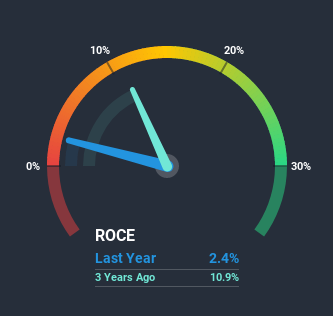- India
- /
- Entertainment
- /
- NSEI:GFLLIMITED
Should You Be Worried About GFL's (NSE:GFLLIMITED) Returns On Capital?
What financial metrics can indicate to us that a company is maturing or even in decline? Typically, we'll see the trend of both return on capital employed (ROCE) declining and this usually coincides with a decreasing amount of capital employed. Basically the company is earning less on its investments and it is also reducing its total assets. In light of that, from a first glance at GFL (NSE:GFLLIMITED), we've spotted some signs that it could be struggling, so let's investigate.
Understanding Return On Capital Employed (ROCE)
For those that aren't sure what ROCE is, it measures the amount of pre-tax profits a company can generate from the capital employed in its business. To calculate this metric for GFL, this is the formula:
Return on Capital Employed = Earnings Before Interest and Tax (EBIT) ÷ (Total Assets - Current Liabilities)
0.024 = ₹1.0b ÷ (₹59b - ₹17b) (Based on the trailing twelve months to September 2020).
Therefore, GFL has an ROCE of 2.4%. Ultimately, that's a low return and it under-performs the Chemicals industry average of 14%.
View our latest analysis for GFL

Historical performance is a great place to start when researching a stock so above you can see the gauge for GFL's ROCE against it's prior returns. If you want to delve into the historical earnings, revenue and cash flow of GFL, check out these free graphs here.
What Does the ROCE Trend For GFL Tell Us?
The trend of ROCE at GFL is showing some signs of weakness. To be more specific, today's ROCE was 13% five years ago but has since fallen to 2.4%. In addition to that, GFL is now employing 37% less capital than it was five years ago. When you see both ROCE and capital employed diminishing, it can often be a sign of a mature and shrinking business that might be in structural decline. If these underlying trends continue, we wouldn't be too optimistic going forward.
The Bottom Line
In short, lower returns and decreasing amounts capital employed in the business doesn't fill us with confidence. Yet despite these concerning fundamentals, the stock has performed strongly with a 45% return over the last five years, so investors appear very optimistic. Regardless, we don't feel too comfortable with the fundamentals so we'd be steering clear of this stock for now.
Like most companies, GFL does come with some risks, and we've found 1 warning sign that you should be aware of.
For those who like to invest in solid companies, check out this free list of companies with solid balance sheets and high returns on equity.
If you decide to trade GFL, use the lowest-cost* platform that is rated #1 Overall by Barron’s, Interactive Brokers. Trade stocks, options, futures, forex, bonds and funds on 135 markets, all from a single integrated account. Promoted
New: Manage All Your Stock Portfolios in One Place
We've created the ultimate portfolio companion for stock investors, and it's free.
• Connect an unlimited number of Portfolios and see your total in one currency
• Be alerted to new Warning Signs or Risks via email or mobile
• Track the Fair Value of your stocks
This article by Simply Wall St is general in nature. It does not constitute a recommendation to buy or sell any stock, and does not take account of your objectives, or your financial situation. We aim to bring you long-term focused analysis driven by fundamental data. Note that our analysis may not factor in the latest price-sensitive company announcements or qualitative material. Simply Wall St has no position in any stocks mentioned.
*Interactive Brokers Rated Lowest Cost Broker by StockBrokers.com Annual Online Review 2020
Have feedback on this article? Concerned about the content? Get in touch with us directly. Alternatively, email editorial-team (at) simplywallst.com.
About NSEI:GFLLIMITED
Excellent balance sheet and slightly overvalued.
Market Insights
Community Narratives



